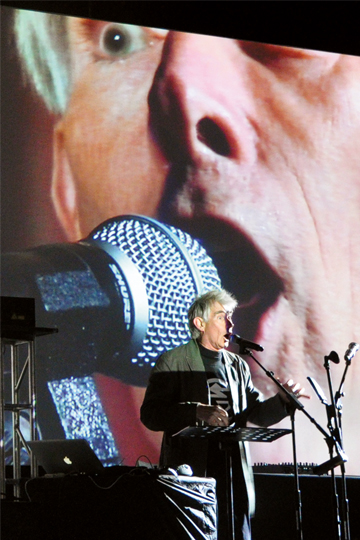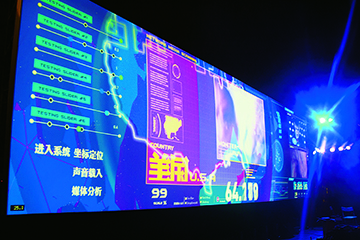NOISE: THE BODY RECALLED
| December 22, 2013 | Post In LEAP 24

A defining property of music is its ordered relationship to time. The experience of sound, on the other hand, is one of disorder. Sound can ring out abruptly, and it can vanish at random. Human understanding has been suppressed by the weight of visual experience. Sometimes, our hearing is a victim of dependence, or even ignored. Other times, for just a moment, it can become suddenly reawakened.
Curator Dajuin Yao’s “Sonart” has been staged on multiple occasions in multiple venues, from performance halls to schools to gallery spaces. The event’s flexibility and openness with regard to the possibilities of media carries inspirational significance the future of multimedia and new media art. The current exhibition, titled “Revolutions Per Minute: Sound Art China” defines the “Beijing Sonart International Music Festival”—that is, the first “Sonart,” held at Loft New Media Art Space in 2003—as the point of origin for all Chinese sound art to follow. At the time sound art had yet to be clearly defined; it was sometimes even labeled as “electronic music.” “Sonart” was the first chance noise had to openly provoke a domestic audience, leaving everyone from the public to the media confused and curious about this new musical form. Now, ten years later, Chinese sound art has taken its first steps onto the global art stage. This very first large-scale group unveiling of sound artists is a continuation of “Revolutions Per Minute: Ten Years of Sound Art in China,” which showed in March 2013 at Colgate University in New York, and will later tour Hong Kong and Europe.
“Revolutions Per Minute” serves as one section of the inaugural “West Bund 2013 Biennial,” and is presented alongside the architecture, video, and theater sections. As far as the biennial at large is concerned, 2013 is an important year, marking the twentieth anniversary of the first participation of young Chinese artists in the Venice Biennale. It is also the centennial anniversary of Stravinsky’s “Rite of Spring,” as well as of the Futurist manifesto of sound, “The Art of Noises.” Sound art is now being formally incorporated into the domestic contemporary art exhibition system. The literal meaning of “revolutions per minute” responds to the accelerated pace and fitful stops and starts comprising the ten year process that was the making of “Sound Art China.” It is also an attempt to look back on and clarify sound art’s position in its own historical context. Though critics and creators alike oppose endowing sound art with any kind of label that might limit its scope, attempted definitions nonetheless hang constantly in the balance. Most broadly, sound art is defined as “all non-musical works are sound art,” and most narrowly, “only sound installations are sound art.” The current exhibition responds to the question of definition with both installation and performance.
The installation section is composed of four huge oil tanks, standing tall amidst industrial ruins on the riverbank. It was an atypical venue that caused some extra logistical difficulty for the exhibition layout. Each tank corresponds to four exhibition zones, all presenting sound installations and archival documents from Mainland Chinese artists as well as artists from Hong Kong and Taiwan. Participants include Fujui Wang, Wang Changcun, and Xu Cheng, all best known for their work as experimental musicians; Shi Wenhua, Jiang Zhuyun, Wang Zhongkun, and Ceng Weihao, graduates of new media programs; and critics Yan Jun, Yin Yi, and Lin Chiwei, among others. The works explore a range of topics relating to the transformation of space, the humanities (and humanism), and various social issues. Among them are investigations into sound production in the Internet age; Zhang Liming (Hitlike)’s piece Harbin Sound Map, a pre-Web 2.0 exploration of field recording and sound mapping, incidentally converges with Dajuin Yao’s The Sound of Social Media, whose central “pai pai” (onomatopoeia for a camera click) function—is a sort of “sound” Instagram, recorded on the spot and instantaneously shared. In line with Jaques Attali’s “political economy of music,” this entirely new, synchronic mode of sound creation—derived purely from user-generated content—is a form very much born of its own times. Meanwhile, RMBit’s work cuts into the same overwhelming wave of redundant information in the social media soundscape but evolves it into live, collaborative performance, in a very allegorical way. This kind of direct audio-visual juxtaposition in one space serves to scrutinize the gaps between forms of sound art as they have developed in three different places, while the inclusion of international artists established an even broader frame of reference. “China Sound Files” and the “Hong Kong Sound Library” play an important textual role in elucidating the comparison.
The exhibition logo itself alludes to sound art’s definitional tensions, bringing together sheng (voice, sound) and yin (tone, sound)—two characters that make up the word for “sound” in the broader sense, while yue (music) is nowhere to be found. This omission implies that art is one entity and avant-garde music is another, and the two are not to be confused. The debate in the global sound art community over how to define sound art versus avant-garde music has been going on for some time. There are indeed inherent differences between sound art and music, but there is still no way to sever the inevitable ties that exist between the two; the mechanisms by which both exist are, in the end, always physically and theoretically interlinked. The international sound art community emphasizes the physical and technical properties, while seeing neglect of the body as a phenomenon inherent to contemporary art, whose knowledge defects against physiological experience. Sound is a real, perceived object, the perception of which we cannot avoid. Bare and exposed, our ears are passive receptors. We can avert our eyes, but we cannot avert our ears. “Listening” is one of the body’s most important behaviors, a behavior from which the body cannot be absent. The “Sonart” performance is this exhibition’s attempt to use noise to bring the audience back to listening itself.

The first night of “Sonart” featured performances involving the visualization of sound: in addition to RMBit’s appropriation of social media, Marco Donnarumma presented a human and technology hybrid generator, and Edwin van der Heide’s laser projectors brought a three-dimensional sound-light illusion into the space. The second night’s performances were more corporeal: Samson Young orchestrated a classical ensemble together with the human heartbeat; Japanese noise pioneer Merzbow, together with Torturing Nurse—heavily influenced by Harsh Noise—shared their anti-social sonic impulses; and Jaap Blonk showcased his vocally improvised Dada sound poetry. The performance portion provided “an opportunity for intimate artist-audience participation—for synchronic, body-to-body, face-to-face meeting.” In a high-decibel live noise setting, everyone present was invited to return to their bodies, to their senses, and to the origins of art itself. It was a moment of open communication that approached the feel of a primitive, shamanistic religious experience.
Within the visual-arts dominated biennial regime, the voice of sound artists has only ever been heard faintly from the periphery. Just as noise grows weaker when it travels from its explosive live house home-base into the unfamiliarly tranquil environment of the museum, the creators of sound art themselves seem to avoid moving too quickly into any sort of confining structure—namely, the clutches of the “contemporary art” system. In fact, they may even actively self-marginalize. According to Lin Chiwei in Beyond Sound Art, the history of sound art is a segmented one, cobbled together from many different directions over many different periods, never emerging up as one temporally linear thread. At times sound art intersected with visual art, with Futurism, Dadaism, Fluxus, as well as other movements. Over the last decade or so, we have witnessed sound’s latest attempt to enter the museum framework, as it moves from noise to sound art. The artists themselves express doubt with regard to the shift, hesitation suggesting an essentially pessimistic undertone. Yet in the realm of contemporary art, there is now a place specially reserved for sound—a welcome new tune at a time when other art forms retreat following struggles to advance forward. The significance of “Sound Art China,” then, lies in its initiation of open public discussion on a range of issues, and its mission to incite introspection and vigilance on the part of domestic sound artists with regard to their historical context. How can radical voices like these find their own currents in the great, complex river that is contemporary art history?

